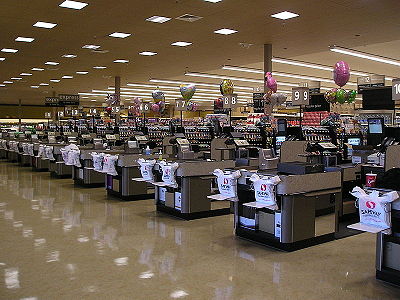Sitopia
Imagine for a moment the simple pleasure of a trip to the grocery store. Remember the first steps into the building. Oh, how the fluorescent lights hum above. Can you remember the particular smell most markets have? The blending of the floral, the produce and the hot deli that makes for a confusing yet comforting feeling of nostalgia? You've been coming here for as long as you can remember, and that smell has never changed.
The long aisles of consumables are packaged just for you. In the space of your mind trolly along blithely and let whatever location you find yourself in define your meal purchases. Over here you have tinned beef stew. Pick up a loaf of freshly made french bread and some smooth sweet cream butter and you've got an old classic meal that will stick to your ribs and keep you cold over the winter. But if you're in the mood for something more exotic, you could simply visit the next aisle over.
Chances are though that your beef stew is made of castaways and cut-offs, the dregs of meals made otherwise. That bread? Made up on the other side of the country, shipped and store, refrigerated the whole way no doubt, and plucked from the refrigerator at 3am and popped in the oven. And should your butter really be that brilliantly yellow?
Sitopia
In her book, Hungry City: How Food Shapes Our Lives, Carolyn Steel says that
"[C]ities are not just made of bricks and mortar, they are inhabited by flesh-and-blood humans and so must rely on the natural world to feed them. Cities, like people, are what they eat."
In later chapters she uses the greek word Sitos to inform new vocabulary
- Sitopia: From Sitos(Food) and Topos (Place)
- Sitopia: A city or town designed with sustainable food usage at the forefront of development and design in order to cure many of the other problems that come with metropolitan living
- Sitosphere: From Sitos and sphaira (Sphere)
- Sitosphere: The area where a community or person's food is grown, processed and moved through
What is the Difference?
What is the difference between a Sitopia and a Utopia?
Utopia, at its very root means both "Good Place" and "No Place." Utopia does not exist, and nor can it because so many of its ideals are unrealistic and impossible to obtain in moral ways.
Examples of Utopia
Sir Thomas More
- (1516)
- Island Community
- City-states with room for neighbors, but each less than a days walk apart
- Capital City
- Houses had ample back yards for gardens that residents loved to work in:
They're extremely fond of these gardens, in which they grow fruit, including grapes, as well as grass and flowers. They keep them in wonderful condition - In fact, I've never seen anything to beat them for beauty or fertility. The people...are keen gardeners not only because they enjoy it, but because there are inter-street competitions for the best kept garden.
- Children are taught farming from a young age.
- All citizens spend mandatory 2 years working the field.
- Work hours were short
- All land and property held in common
- Families came together with neighbors for communal meals
St. Gall Plan
- 9th century
- Normal Monastery Buildings: Church, School, cloister, infirmary, kitchen, kitchen, dinning hall, guest houses, cemetery
- Abnormal buildings: Cowsheds, Stables, housing for pigs, sheep, geese, hens, a barn, a threshing floor, brewery, and a bakery
- The earliest example of a planned utopia
New Lanark
- 1799
- Indentured servants turned eager with shorter hours
- Rewarding good behavior and deeds.
- installed high quality housing,a school and a non-profit shop
- villages of 1200 people working 1500 acres of land
Garden Cities
- 1898
- 6000 acres, 1000 of which would be built up and the rest used for agriculture
- all land and properties held in common, with rent being payed to bolster the city so that rather than land owners the city gets rich, rather than land owners.
- Cities would be laid out in concentric circles:
- Central public park bordered by a combination winter garden/market
- Grand Avenue 150 meters wide
- 200 people per hectare in residential areas
- Maximum population of 30,000 with an additional 2000 to work the land
- When population cap was reached, a satellite city would be founded; connected by railway
- Central City with a population of 58,000
"We should have a cluster of cities...each inhabitant of the whole group, though in once sense living in a town of small size, would be in reality living in, and would enjoy all the advantages of a great and most beautiful city; and yet all the fresh delights of the country - field, hedgerow, and woodland - not prim parks and gardens merely - would be within a very few minutes walk or ride."
Dongtan
- 2020
- Most people walk or ride bikes
- Residential buildings combined with hydroponic farms
- Waste water recycled for use in hydroponic farms
- Restaurant feature localize menus exclusively
- Offshore wind farms
- 80,000 people
- Roofs covered in vegetation to reduce rain water run off and improve thermal performance
- Consolidation stations strip out all incoming packaging and recycle it.
Civic Intelligence Patterns
The Commons
<poem> The law locks up the man or woman Who steals the goose from off the common, But leaves the greater villain loose Who steals the common from the goose</poem>

